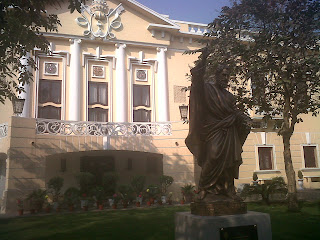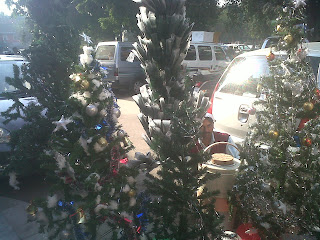A lot to be thankful for this year: a wonderful husband, loving parents and in-laws, a job that enables me to travel the world learning about various healthcare models, continued adventures in India...
And now... a definitive answer to: "When are you moving back to NYC?" Tyler got into Columbia Business School! Woohoo!! I have to hand it to Columbia on impeccable timing: calling the evening before I arrived home (a day earlier than expected), so we could celebrate all weekend and have even more to be thankful for on Thanksgiving.
This year, we've gone all out. Last year, we celebrated Thanksgiving with the closest thing we could find to a turkey: Peking Duck at the Sheraton. That became our celebration dinner last Saturday night. Then Sunday, our friends had us over to their gorgeous house at the American Embassy for an early Thanksgiving feast.
The chef d'oeuvre? Without a doubt, the giant turkey smuggled into India from friends visiting from DC (It's illegal in India to bring in meat, poultry, etc). I must say, I was duly impressed: a two week vacation to India bringing their nine month old daughter and a giant turkey, from Whole Foods no less (not to mention fresh cranberries for sauce and a cake).
Four couples, seven children, ranging in age from 6 months to 6 years. When going around the table saying our gratitudes, it was touching that many of the kids said, "I'm grateful for living in India."
Tomorrow, we've invited a group of friends to the Living Room, a restaurant in the artsy (for India) neighborhood of Hauz Khas. Can't wait for another serving of stuffing!
On the subject of gratitude, I was shocked to learn in Hindi class yesterday that Indians don't really have an expression for, "I'm grateful for...". "May kritgya oo" may be the closest thing, but it is rarely used. I joked to Tyler that Indians don't send thank you cards after weddings (which perhaps is good considering a "small" wedding is 800+ guests!), and he reminded me that Indians rarely say thank you when you hand them a gift at all.
My Hindi teacher shed more light on this phenomenon yesterday, explaining that Indians don't thank others for actions or gifts because they see the gift as a gift from God -- working through mere humans. In other words, why should I thank my neighbor for bringing over food, when it's really God bringing me gifts through my neighbor. Interesting thought model to ponder...
Relatedly, Indians rarely use the future tense, instead using the subjunctive -- which, as we learned from 10th grade English, is used when the future is not known. My Hindi teacher recommended that I watch how often I use the future tense ("I will go to a movie tonight") and instead use the subjunctive ("I may go to a movie tonight") -- as using the future too much sounds presumptive and arrogant. Hmm... definitely gives insight to my frustrations when colleagues would say that a document "may" be ready in a few hours...
A last word on gratitude. I just read an article about research done by Dr. Robert A. Emmons, who found that individuals who wrote down what they were thankful for on a weekly basis were 25% happier, more optimistic about the future, felt better about their lives, and exercised 1.5 hours more per week than those who didn't record their gratitude. One of the best "rituals" that Tyler and I received advice about was from our pre-cana teacher in NYC, who suggested thanking your partner every night before bed, for the various things they had done during the day. We've been doing our "gratitudes" nearly every night for the past six months now, and I highly recommend it.
After all, giving thanks shouldn't just happen once a year.


















